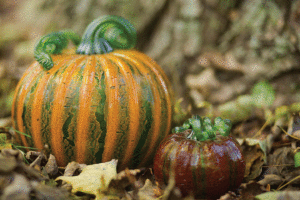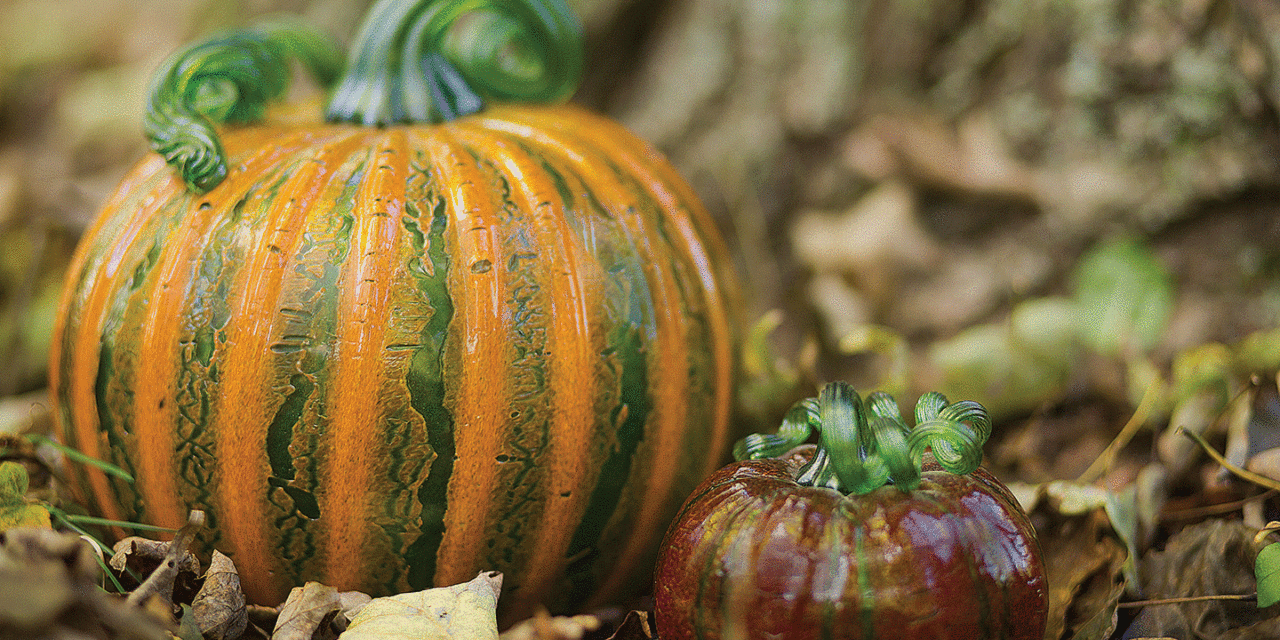
Glass-blown pumpkins span from traditional colors to all types of shapes and shades. (Photo courtesy Corning Museum of Glass)
Fall is forever pumpkin season.
But handcrafting, instead of planting, creates some of today’s hottest varietals, harvested from molten glass, plush velvet and sparkling Swarovski crystals.
From the Corning Museum of Glass in New York to the Morton Arboretum in Chicago, and throughout California, folks are flocking to glass pumpkin patches and farmers’ markets.
And in Oregon, a cadre of cutters, sewing experts and stuffers prep endless orders for plush fabric orbs, some from as far away as Ireland.
The Glass Farmer’s Market on the Corning campus has become an annual autumn attraction.
Shoppers “pick” from a multitude of shapes, sizes, and colors of shimmering pumpkins (plus apples, acorns, and more) in person or via the online store.
Each sale helps fund the museum’s educational mission.
For those wanting more of a hands-on (or in this case, air-in) experience, Corning offers craft your own pumpkin classes through Nov. 30.
After choosing their color participants begin the shaping process by safely blowing into the cool end of a glassblowing iron.
A professional glassblower then manipulates the molten glass on the other end, removes it, and adds a finishing stem.
The piece slowly cools overnight to be ready for pick up or shipment the following day.
The Morton Arboretum’s Glass Pumpkin Patch is another new tradition, now in its 9th year, where more than 6,000 luminous pumpkins go on sale.
Among the 15-plus contributing U.S. artists is Shannon Jane Morgan of Girl Glass Studio, Sacramento, California, who co-founded the inaugural “patch” with Arboretum Store Manager Jacques Fucilla.
Returning as she has each year to help grow the event, the self-taught Morgan, with 20 years of creative glassblowing expertise, oversees the educational glassblowing classes and takes part in live demonstrations.
It’s fitting that a prime mover behind Morton Arboretum’s glass pumpkin event has California roots.
The golden state boasts the most glass pumpkin festivals with at least half a dozen, according to California.com.
The largest and longest running (24 years) is Palo Alto’s Great Glass Pumpkin Patch, co-sponsored by the Bay Area Glass Institute and the Palo Alto Arts Center (Community Services and Foundation).
Held on Sept. 28-29, this year’s extravaganza featured displays of 10,000 glass pumpkins, with live glass blowing demonstrations every half hour.
Admission remained free, and profits from pumpkin sales benefit art education and outreach activities of both organizations as well as the artists.
Damon Gustafson, Executive Director of BAGI in San Jose, traced the festival’s origins to the group’s founders, San Jose State University grads Mariko Takada, Jonathan Tepperman, Mike Bennard and Bobby Bowes.
No longer able to access the fully equipped “hot shop” housed in the industrial arts building at SJSU, they started BAGI in Bowes’ backyard, Gustafson explained.
Crafting glass pumpkins helped pay the bills and open a public access hot shop where all interested could learn and create, he added.
In the mid-1990s BAGI held inaugural glass pumpkin patches at MIT, the Santa Fe Children’s Museum, and the Palo Alto Art Center (its eventual permanent home).
Overwhelming public response inspired a “spin-off” glass pumpkin patch at Santana Row, San Jose’s high-end commercial district, now in its 5th year.
Glass artists Ingrid and Ken Hanson of Hanson and Kastles Handblown Art Glass in San Carlos, Calif., were at first reluctant to jump on the glass pumpkin bandwagon, wary of diluting the unique flair they’d developed over 20 years. But the chance to help raise dollars for art and community nonprofits convinced them it was worth a try.
With signature touches of poppy and sunflower embellishments plus their own millefiori glass, the Hansons more than met their own creative standards.
This year the Corning Museum of Glass in New York named their Iridescent silver-blue finish design topped with iridescent gold “Pumpkin of the Year.”
The couple creates a stash of 1,000 hand-blown pumpkins before the Great Glass Patch and four other festivals spanning September and October.
But orders pour in from buyers and galleries, as well as their Etsy Shop and Artful Home’s online pumpkin “patch”, depleting their stockpile.
“No matter how many we start with, now through the end of October we’re busy each day replenishing the supply,” she said.
Daria Knowles didn’t set out to create a plush pumpkin empire. But people can’t seem to resist the magical combination of her velvet orbs fused with natural pumpkin stems. And it all happened by accident.
Following college and a competitive figure skating career, she moved to Arizona and “got into sewing” home decor.
Using the damask velvet planned for a shower curtain she somehow created a one of a kind velvet pumpkin; her friends loved it.
Moving to Oregon and finding a few left over, she showed them to local store owners who responded by deeming them “hot.”
One pivotal proprietor, Richard Bloom of Lake Oswego, brought her pumpkins to use as display props for ornaments at Atlanta’s International Gift Show.
He soon called to report that people were most interested in her creations, and asked “how about if I take $12,000 worth of orders?”
Her friends pitched in, cutting, sewing, and stuffing the pumpkins, and attaching leftover natural pumpkin stems she was able to glean at a neighboring farm.
Over the next few years the newly christened “Hot Skwash” cottage business took off.
Each day, after their kids left for school, a core crew of 12 or 13 neighborhood women headed to Daria’s house to make pumpkins.
The afternoon school bus dropped the youngsters at her door, and pumpkin making continued.
“My foyer was the shipping area, and the dining room was wall to wall bolts of velvet,” she laughed.
Eventually the “lifestyle business” as she calls it spilled into a remodeled garage and newly built 9,000-square-foot warehouse.
With know-how from farmers and seed distributors a sample patch now supplies an evolving assortment of homegrown real pumpkin stems — some thick, some twisty, all contributing character for each Hot Skwash creation’s finishing touch.
The 2019 catalog features velvet pumpkins in 60 colors from 2 to 16 inches across, the largest designated “Luca” after Daria’s pet mastiff.
Fabrics now include cashmere and Italian Missoni. Adornments range from feathers to Swarovski crystals and European ribbon with hand wrapped silk velvet rosettes known as “birdcage” design.
The decor cornucopia has expanded to include bejeweled ears of corn, pomegranates, and artfully appointed mushrooms, acorns, strawberries, and hearts, and more than a few notable custom orders, among them, a DeBeers diamond trimmed pumpkin purse perched on a golden stand, commissioned as a fundraiser, which sold for $10,000, an out-sized pumpkin displaying a Chicago area jeweler’s $1.3 million diamond and ruby necklace and Las Vegas’ Bellagio Hotel and Casino.




